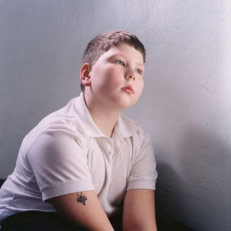
| HOME |
| NERVE |
| REVIEWS |
| ARCHIVE |
| EVENTS |
| LINKS |
| ABOUT US |
| CONTRIBUTORS |
| BACK ISSUES |
| CONTACT US |
 New
Works
New
Works
Hellen van Meene
Open Eye Gallery, Wood Street
21st July - 2nd September 2006
Reviewed by Hana Leaper
Fleshily depicted and posed in the manner of Vermeer, van Meene has provoked comment on the nature of her photographic portraiture. There are the obvious references to the old Dutch masters, the debate critics seemingly find fascinating between whether the pictures are documentary or portrait, fantasy or reality; whether her exclusive concentration on teenagers eroticises them. The blurb for New Works claims that ‘Her photographs are neither exploitative, nor strictly collaborative, nor entirely staged’. I’m not sure I agree; the children shown seem caught like lobotomised rabbits in van Meene’s photographic headlights, and unlike the old masters - who depicted the flesh of their subjects with such sensuous strokes - she seems to have felt no love for her subjects. They are - as Vermeer’s models - objectified, but without the loving rendering. And they stare - goldfish like - glassily, emptily, out from the desolate, eastern-block-like empty squares of the composition, uniformly blank, ugly and cheaply attired. There are two exceptions. A teenage mother from London who closes her eyes as she dreamily, tentatively touches her bulging belly, allowing her plastic pink coat to flap in the breeze on an urban street corner, she seems transported, unaware of her surroundings. And another teenage mother in Heiloo, photographed in a wood, in her shabby underwear, eyes clenched shut, stretchmarks like welts across her belly, hands bound to her sides by her knickers. It is seems that perhaps van Meene asked these two to shut their eyes, to prevent their emotions escaping out through them, to prevent the composition of stretched exposed teenage skin being invaded and the clear round lines of the composition being by stretched, exposed teenage emotion.
It’s an interesting inversion: the blank, beautiful, carefully-styled teenage models, whose images are carefully and successfully sculpted by photographers like David Bailey are replaced, in a cheap trick with blank ugly, unstyled, poor, socially unacceptable teenagers, utterly bereft of glamour
But why should the ugly, miserable, young people automatically seem interesting or any more emotionally engaged/engaging? I feel somehow, that these ‘portraits’ are utterly exploitative, and that I too have somehow been dangerously exposed by witnessing them. Van Meene leaves you unable to believe in the fantasy that putting someone in front of a camera gives them meaning, allows them to tell their story. She has given her models no props, nothing to hide behind or give clues about their lives, nor - as in a fashion photo shoot - constructed a story or an identity for them. They are selling nothing, therefore they are saying nothing. They’re ‘real’, but the shots, although they look ‘real’, are not, they are posed. We understand that in glossy photoshoots the ‘glamour’ is constructed, is meant to blind us; yet it is hard to understand, without the clever lighting, make up and allure, that these pictures are also not ‘real’. And you try continually to make stories, but her masterstroke is that she allows you no redeeming sparks of humanity. We can forgive vacuity for beauty - that’s easy - but it seems hard to accept ugly uniformity without a good story to go with it.
They’re blank canvasses with nothing projected onto them, or maybe projections with no canvasses onto which to inscribe themselves. Van Meene doesn’t allow them this. You realise that you expect to be pulled in some direction (empathy, sympathy, pity, aesthetic appreciation) and that you’ve been disappointed. In turn you become disappointed in yourself, that you are so deeply indoctrinated by a culture of voyeurism that demands freak shows for entertainment. You leave realising that you actually wanted a Jerry Springer show, that you - like every other consumer in the nation - crave emotional porn. You leave feeling, bitter, as though you weren’t invited.
Van Meene has constructed an exhibition of ingeniously impenetrable surfaces, which ultimately force unfavourable self-examination.
Printer friendly page